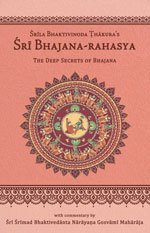Bhajana-Rahasya
by Srila Bhaktivinoda Thakura Mahasaya | 2010 | 123,965 words
The Bhajana-rahasya Text 26, English translation, including commentary (vritti). The Bhajana-rahasya is a compilation of verses describing the mercy of the eight pairs of names (Yugala-nama) of the Maha-mantra. This is text 26 belonging to the chapter “Shashtha-yama-sadhana (Sayam-kaliya-bhajana–bhava)” representing six dandas after dusk: approximately 6.00 p.m.–8.30 p.m.
Text 26
Even devotees inclined towards Śrī Bhagavān’s opulence (aiśvarya) long to attain gopī-bhāva.
This is stated in Śrīmad-Bhāgavatam (10.44.14):
गोप्यस् तपः किम् अचरन् यद् अमुष्य रूपं लावण्य-सारम् असमोर्ध्वम् अनन्य-सिद्धम्
दृग्भिः पिबन्त्य् अनुसवाभिनवं दुरापम् एकान्त-धाम यशसः श्रिय ऐश्वरस्यgopyas tapaḥ kim acaran yad amuṣya rūpaṃ lāvaṇya-sāram asamordhvam ananya-siddham
dṛgbhiḥ pibanty anusavābhinavaṃ durāpam ekānta-dhāma yaśasaḥ śriya aiśvarasyaSakhī, I do not know what austerities the gopīs have performed to be always drinking the sweetness of Kṛṣṇa’s form with their eyes. What is the nature of His form? It is the essence of bodily beauty (lāvaṇya-sāra)! Within this material existence or above it, there is no beauty equal to His, what to speak of a greater beauty. He is not decorated by anyone, nor is He perfected by ornaments and clothes. Rather, He is perfect in Himself. While seeing this form, one does not become satiated, because its beauty increases at every moment. All fame, beauty and opulence take shelter of it. Only the gopīs are fortunate enough to have such a darśana of Kṛṣṇa;no one else.
यशः श्री ऐश्वर्य-धाम दुर्लभ एकान्त
अतीव-लावण्य-सार स्वतः-सिद्ध कान्तyaśaḥ śrī aiśvarya-dhāma durlabha ekānta
atīva-lāvaṇya-sāra svataḥ-siddha kāntaकि तप करिल गोपी याहे अनुक्षण
नयनेते श्याम-रस करे आस्वादनki tapa karila gopī yāhe anukṣaṇa
nayanete śyāma-rasa kare āsvādana
Commentary: Bhajana-rahasya-vṛtti:
This Text was spoken by the young, beautiful women of Mathurā in Kaṃsa’s wrestling arena when they had received darśana of Śrī Kṛṣṇa’s unprecedented lustrous body. Amazed by that form, they yearned to taste it. They said, “O sakhī, what kind of austerities have the gopīs performed to be able to fill their eyes with the extraordinary beauty of Śrī Kṛṣṇa’s form (rūpa-mādhurya )? They have made their birth, body and mind successful. What is this beauty like? There is no rūpa-mādhurya equal to or greater than this. In Paravyoma, there are so many forms of the Supreme Lord, but even Nārāyaṇa, Śrī Kṛṣṇa’s pastime expansion (vilāsa-mūrti-svarūpa), does not have such rūpa-mādhurya, what to speak of other forms.”
Śrī Kṛṣṇa’s beauty is topmost. It is incomparable, perfect and natural, and it is not brought about by any kind of ornamentation. In fact, it is both the origin and treasury of all beautiful, sweet qualities. Śrī Kṛṣṇa’s form, which is filled with unequalled beauty, is only present in Vṛndāvana, and Vrajabhūmi is blessed because the Original Person (purāṇa-puruṣa) performs pastimes there in disguise. In this Vrajabhūmi, the vraja-devīs are especially blessed because they received darśana of dhīra-lalita-nāyaka Śrī Kṛṣṇa, who is adorned with all beauty and sweetness.
By the word amuṣya, the women of Mathurā note, “Today in this wrestling arena, by our insignificant piety, we are receiving Śrī Kṛṣṇa’s darśana, but the gopīs’ piety is complete. O omniscient munis, please direct us how to perform austerities like those performed by the gopīs, so that we also will be able to gaze upon Śrī Kṛṣṇa’s sweet form in Vraja.”
Another woman of Mathurā said with amazement, “O sakhī, the good fortune of the vraja-devīs is not the result of any austerity; their prema is without cause and cannot be expressed in words.” If she had said, “We can also go to Vraja and drink the nectar of Kṛṣṇa’s beauty like the gopīs,” another lady would have replied, “That is very difficult for us. Only by the mercy of the gopīs, who possess the topmost prema, is it possible to drink this nectar.”
Another lady started speaking. “Oh! In front of the vraja-gopīs, Śrī Kṛṣṇa’s beauty manifests in newer and newer forms, uninterruptedly, moment by moment.”
The women of Mathurā glorified the good fortune of the vrajadevīs and eagerly desired to serve as they do. They used to hear from the fruit-sellers and others coming from Vraja about the sweet pastimes of Śrī Kṛṣṇa and the vraja-devīs. By hearing descriptions of these pastimes, a yearning for the services the gopīs perform arose in their hearts.
